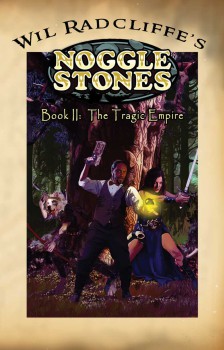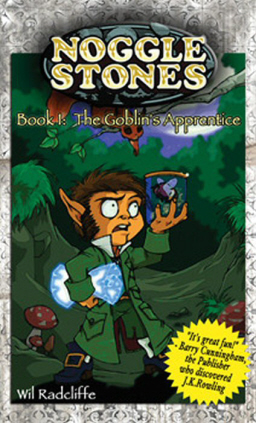Self-published Book Review: The Tragic Empire by Wil Radcliffe
 If you have a book you’d like me to review, please see the submission guidelines here.
If you have a book you’d like me to review, please see the submission guidelines here.
Back when I reviewed the first Noggle Stones book, The Goblin’s Apprentice, I knew there was a sequel. Of course I could only review one book at a time and I figured I should start at the beginning. Though I really enjoyed the first volume, I didn’t want to review books in the same series two months in a row, so I couldn’t cover the second book right away. Now that it’s been a year, enough time has passed for me to take on the sequel.
The Tragic Empire takes place a few months after the events of the first book. Martin Manchester is settling in as the king of Willow Prairie, establishing alliances with the nearby realms of dwarves, ogres, and other folk. The goblin Bugbear serves as Manchester’s diplomat while pursuing his own investigations, with a particular interest in discovering what force was behind the Shadow Smith, the villainous mastermind of The Goblin’s Apprentice. To that end, he’s allowed himself to be thrown into an Áes Dána prison, in hopes of finding access to their archives, which contain works dating back to the Coranieid Empire. After a tricky escape and some fancy diplomacy, it seems that Bugbear may get what he wants, until the US Army attacks the Áes Dána.
Which answers one of the lingering questions of the first book. We saw what happened to the town of Willow Prairie when our world of 1899 merged with a world of ogres, goblins, and dwarves, but there was no indication of what happened to the rest of the world until now. Surely someone in Washington noticed all these strange people appearing from nowhere and decided to do something about it. War against the invaders would be an obvious option.
That said, it turns out that the US wasn’t the one who started this war. That began with Áes Dána attacking a garrison near Toledo, which of course they denied doing. But the true enemy isn’t the US Army or the Áes Dána: it’s a new force, the Baymaari. The Baymaari isn’t a person so much as a plague, one of hopelessness which seizes the broken, the weak, and even the dead, turning them into soldiers to attack the uninfected. Most of those turned are mindless drones, but some retain their intelligence and are able to lead the less intelligent ones effectively.
 While Bugbear quests to learn more of this danger, accompanied by the US agent Asherby and the deposed, inept Áes Dána king Brenen, Martin Manchester travels to Washington in order to find a peaceful resolution to the war between the US and the Áes Dána. He’s accompanied by a contingent from Willow Prairie, including his patchwork ward, Riley, and his wife and Dragon Bride, Maga. At this point, the already sizeable cast of characters grows even larger, adding the unseelie Queen Rígan, the Dabblers Bixby and Cobblestone, more patchworks, humans, and even Vice President Teddy Roosevelt, once the characters arrive at Washington to find it under siege. For a relatively short book, there are a lot of characters and the author does a surprisingly good job of keeping them all straight, giving each one his place in the spotlight while avoiding crowding out the main characters, who, as in the first book, are Manchester and Bugbear, and to a lesser extent, Riley and Maga. Of the new characters, only Asherby rises to that level, and even though they have important roles in the book’s resolution, Queen Rígan and King Brenen are still fairly minor characters. Keeping the other characters more in the background helped to prevent the expanding number of characters from becoming too distracting, as they can become in certain massive cast epic fantasies which shall remain nameless, but go by initials such as WoT and ASoIaF.
While Bugbear quests to learn more of this danger, accompanied by the US agent Asherby and the deposed, inept Áes Dána king Brenen, Martin Manchester travels to Washington in order to find a peaceful resolution to the war between the US and the Áes Dána. He’s accompanied by a contingent from Willow Prairie, including his patchwork ward, Riley, and his wife and Dragon Bride, Maga. At this point, the already sizeable cast of characters grows even larger, adding the unseelie Queen Rígan, the Dabblers Bixby and Cobblestone, more patchworks, humans, and even Vice President Teddy Roosevelt, once the characters arrive at Washington to find it under siege. For a relatively short book, there are a lot of characters and the author does a surprisingly good job of keeping them all straight, giving each one his place in the spotlight while avoiding crowding out the main characters, who, as in the first book, are Manchester and Bugbear, and to a lesser extent, Riley and Maga. Of the new characters, only Asherby rises to that level, and even though they have important roles in the book’s resolution, Queen Rígan and King Brenen are still fairly minor characters. Keeping the other characters more in the background helped to prevent the expanding number of characters from becoming too distracting, as they can become in certain massive cast epic fantasies which shall remain nameless, but go by initials such as WoT and ASoIaF.
The most prominent newcomer, Asherby, is presented as an intelligent and competent man, being forced to operate outside his area of competence. For the most part, he manages to muddle on until he finds his feet and plays a pivotal role at the end. He never manages quite the level of brilliance that Manchester sometimes achieves, but he also bumbles a good deal less.
While the heroes were many and varied, the villains were significantly less distinctive than in the previous book. The Baymaari is a plague, a disease of hopelessness that can only be overcome with hope. It lacks the true intelligence of a mastermind like the Shadow Smith, who despite his few scenes in The Goblin’s Apprentice, was still a menacing force behind the troubles our heroes faced. Much more present in that book, and therefore more of an immediate threat, were Cron and her army of patchworks. These memorable enemies don’t make an appearance in this book, as being dead is a significant (though not insurmountable) hindrance, and what we do get is something similar to a zombie plague. These zombies, though, are not defeated by headshots and beheadings, but by the symbols of hope. Some of these–such as cross-tipped bullets–are pretty cool, while others—such as a sappy love letter—are considerably less so. When it comes to the conclusion, though, the ending is less deus ex machina than the previous book, as the key to defeating the Baymaari has been clearly laid-out and all the pieces to the plan well positioned without being telegraphed.
I believe that the author has improved in many ways since his first book. Like the first book, The Tragic Empire seems aimed at a young adult audience, with the same mix of whimsy and drama, and with an ending a tad on the saccharine side. He still sometimes goes a little overboard with his wordplay, but it’s less prominent and distracting than in The Goblin’s Apprentice. The plotting is tighter and better focused, and as I’ve said, he does a good job of juggling the characters and setting up the ending. I do hope that he gives us a more memorable villain for the next novel, at least one of which he clearly has in mind given the book’s ending.
The Tragic Empire is available as an ebook for $2.99 (Barnes & Noble, Amazon, Smashwords) and as a paperback for $14.95 or less (Amazon, Barnes&Noble, Books-a-Million). Signed copies are available at 3Rivers Archery.
Donald S. Crankshaw’s work first appeared in Black Gate in October 2012, in the short novel “A Phoenix in Darkness.” He lives online at www.donaldscrankshaw.com.